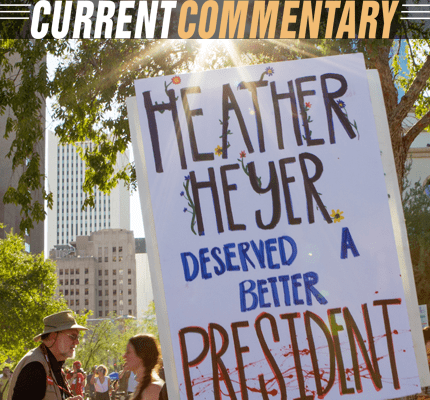
Making Sense of Privilege through Dominant Group Theory
By Robert J. Razzante
The academic school year comes to a close and I am left reflecting on the year that was. The week before classes began, members of a White nationalist group voiced their fears of disenfranchisement in Charlottesville, VA. The group of predominantly White men marched on the University of Virginia’s campus, carrying lit tiki-torches that illuminated the campus in a long line of fire. Rising from the procession were chants of “you will not replace us,” and “blood and soil.” As a White male instructor teaching intercultural communication in a red state, I found that my body became a site of tension for myself and my students. My body became interpellated into the rhetoric surrounding White supremacy, defensiveness, and fear. My body also became interpellated into the rhetoric of higher education as left-leaning. As I prepared for the semester, I began to reflect critically on how my communicative strategies could feed into one of the two camps.
The day after the tiki-torch march, Heather Heyer, a White anti-White nationalist was murdered while protesting the racist hate group that had marched the night before. Heather made a conscious effort to communicate in a way that publicly denounced White nationalism. She communicated in a way that put the needs and desires of historically marginalized groups before the fears and concerns of White nationalists. There may not be a right or wrong way to confront oppressive rhetoric. Rather, kairos, or the time and place, requires certain communicative behaviors. Many influential factors may have encouraged Heather to take the stand that she did.
In an interview with CNN, Heather’s father noted that Heather had always been one to stand up for those on the margins of society. He later stated that Heather, “would never back down from what she believed in. And that's what she died doing, she died fighting for what she believed in,” and that, “she had a bigger backbone than I did.” Heather’s experience as a freedom fighter led her to strengthen her backbone and mobilize herself to march in protest. However, before moving herself to protest, Heather had also anticipated the potential harms of joining the protest; she was aware of the possibility of the presence of an active shooter. In a conversation with a colleague the day before, Heather had cautioned, “I want to go so badly, but I don't want to get shot. I don't want to die.” Recognizing the perceived cost of death, Heather still valued anti-discriminatory work at a higher value. Heather valued justice above the possibility of her own death.
The rhetoric of justice was also used to mobilize a group of people for the White nationalist march. For White nationalists, justice was used to advocate their concerns of their own racial and economic disenfranchisement. Those White men may also have been acting out of the fear of being pushed to the margins by racial minorities and experiencing the threat of losing jobs. Both the White nationalists and Heather Heyer utilized their abilities to mobilize themselves into protest. Both had the intentions of justice. However, the efforts of each side had drastically different ramifications.
Communication scholars have always grappled with the question of intent versus impact. In a generous interpretation, the intent of both sides may have been to gain more equitable living conditions. However, the impact of the protests revealed alternative intentions of particular individuals. As such, Heather Heyer became the unfortunate victim of uncivil protest. The impact of White supremacist protesting reinforced White supremacy through the ultimate silencing of Heyer’s voice.
The situational context of the protests helps to give meaning to what happened in Charlottesville. A colonial history of White supremacy has led to contemporary racial relations in the United States. While White supremacy exists, not all Whites advocate White supremacist ideology. As demonstrated by Heather Heyer, Whites can act differently, depending on the kairos of the moment. As I reflect on the year that was, I feel myself questioning my relationship to Heather’s actions. Would I have marched out of protest? How should I teach power, privilege, and oppression to my students in intercultural communication?
Dominant group theory (DGT) provides a framework to engage the dialectical tension of privilege – marginalization. With roots in co-cultural theory, DGT provides a framework for understanding ways that privilege informs one’s communication. Considering that identity is complex, intersectional, and dynamic, dominant group theory takes into account communication in particular contexts. In the context of Charlottesville, DGT can be used to examine the interactional outcome of particular communicative strategies enacted by those with power and privilege. In Charlottesville, Heather Heyer worked to disrupt racism at the expense of her own life. While we should not advocate death, the possibility of death should not be ignored. In contrast, the White nationalists, also protesting from a position of White privilege, reinforced White supremacy through their actions. As the author of this essay, my actions may not parallel either the White nationalists’ or Heather Heyer’s. Rather, engaging this topic may impede discourse surrounding White supremacy by raising awareness about the complexities of power and privilege.
As students, educators, and practitioners, we can use dominant group theory to educate ourselves on the potential implications of our communication from positions of privilege (whether it be in terms of class, ability, gender, race, etc.). However, rather than assuming a potential action results in a particular outcome, it is best to consult with marginalized groups before acting. Rather than teaching our White students to mobilize themselves to protest, responsible educators may encourage students to embed themselves and engage with communities of color. Through such experience, the kairos of a moment may call for different uses of privilege. As Brenda J. Allen (University of Colorado, Denver) advocates, those with privilege may be response-able, but not all responses are responsible. Identifying communication as (ir)responsible is not easy. Dominant group theory and an awareness for coalition building help to embrace the complexity of power and privilege.
References
- Orbe, M. P. (1998). Constructing co-cultural theory: An explication of culture, power, and communication. Thousand Oaks, CA: Sage. doi: 10.4135/9781483345321
- Razzante, R. J. (forthcoming). Identifying dominant group communication strategies: A phenomenological study. Special Issue of Communication Studies.
- Razzante, R. J., & Orbe, M. P. (in press). Two sides of the same coin: Conceptualizing dominant group theory in the context of co-cultural theory. Communication Theory.
Additional Communication-Based References
- Barge, J. K. (2001). Practical theory as mapping, engaged reflection, and transformative practice. Communication Theory, 11(1), 5-13.
- Cunliffe, A. L. (2009). The philosophical leader: On relationalism, ethics, and reflexivity – a critical perspective to teaching leadership. Management Learning, 40(1), 87-101.
- Halualani, R., Mendoza, S., & Drzewiecka, J. (2009). “Critical” Junctures in Intercultural Communication Studies: A Review. Review of Communication, 9(1), 17-35. doi: 10.1080/15358590802169504
- Moon, D. G. (2010). Critical Reflections on Culture and Critical Intercultural Communication. In T. K. Nakayama & R. T. Halualani (Eds.), The Handbook of Critical Intercultural Communication (pp. 34-52): Wiley-Blackwell.
Online Resources
- Difference Matters: A Resource on Diversity, Identity, and Communication
- The Highlander Research and Education Center: https://www.highlandercenter.org
- PRAXIS: The Blog of the Journal of Critical Scholarship on Higher Education and Student Affairs
- Teaching Tolerance
Media Resource: Issue Experts
- Judith N. Martin, Professor emerita at Arizona State University


